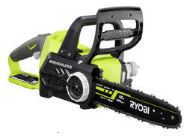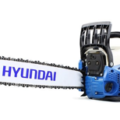If you are new and inexperienced to using Chainsaws, then please make sure to view the videos outlined below which outline the basic principles if using a chainsaw, how to safely use a chainsaw and also how to maintain and fell a tree with a Chainsaw.
Chainsaws are a versatile tool used for a variety of purposes, such as pruning trees, cutting firewood, and even demolition work. There are several types of chainsaws available on the market, each designed to meet different needs and preferences and there are some of the most common types of chainsaws you will find on sale
Gas-powered chainsaws
These are the most popular and powerful chainsaws available on the market. They are designed to handle heavy-duty jobs and are ideal for professional loggers, arborists, and homeowners with large properties. Gas-powered chainsaws are known for their durability and can cut through large trees with ease. However, they are also the noisiest and require regular maintenance.
Read also: Popular Wheelbarrows here
Chainsaw Video Tips Compilation
Video 1 - How to Use a Chainsaw
Electric chainsaws
These chainsaws are powered by electricity and are designed for lighter jobs such as pruning and trimming trees. They are quieter than gas-powered chainsaws and are suitable for use in residential areas. Electric chainsaws are also lighter and more affordable than gas-powered chainsaws. However, they have less power and are limited by the length of their cords.
Battery-Powered Chainsaws
These chainsaws are powered by rechargeable batteries and offer a balance between power and convenience. They are lighter and quieter than gas-powered chainsaws, and their cordless design makes them easy to use in remote areas. However, they have limited run times and may not be suitable for heavy-duty tasks.
Pole Chainsaws
These chainsaws have an extended pole that allows users to reach high branches without the need for a ladder. They are designed for pruning and trimming trees and are ideal for homeowners with tall trees. Pole chainsaws are available in gas-powered, electric, and battery-powered models.
Top-handle Chainsaws
These chainsaws are designed for arborists and tree climbers who need to work in tight spaces. They have a compact design and a handle on top that allows users to manoeuvre the saw easily. Top-handle chainsaws are available in gas-powered and electric models.
Heavy Duty or Lighter Tasks
The type of chainsaw you choose will depend on the task at hand and your personal preferences. Gas-powered chainsaws are ideal for heavy-duty jobs, while electric and battery-powered chainsaws are suitable for lighter tasks. Pole chainsaws and top-handle chainsaws are designed for specific uses and are ideal for professionals who need to work in tight spaces or at heights.
Read also: Popular Garden benches here
Video 2 - How to Safely Use a Chainsaw, Basic Tips
How to Use a Chainsaw Safely
Using a chainsaw can be a dangerous activity if not done correctly. It is important to follow safety guidelines and learn how to use a chainsaw properly before operating it so here are some steps to follow when using a chainsaw for your own safety
1, Wear protective gear: Always wear protective gear, including a hard hat, safety glasses, earplugs, heavy-duty gloves, and steel-toed boots. Make sure your clothing is tight-fitting and doesn't have any loose ends that could get caught in the saw.
2, Inspect the chainsaw: Check the chainsaw for any defects or damage before use. Make sure the chain is properly tightened, the bar and chain oil reservoirs are full, and the air filter is clean.
Video 3 - How to Fell a Tree with a Chainsaw
3, Plan your cuts: Plan your cuts before starting the chainsaw. Identify the location of the felling notch, back cut, and hinge before beginning the cut.
4, Start the chainsaw: Place the chainsaw on a flat surface and press the primer bulb several times to pump fuel into the carburettor. Set the choke to the "on" position and pull the starter cord until the engine sputters. Move the choke to the "off" position and pull the starter cord again until the chainsaw starts.
5, Hold the chainsaw correctly: Hold the chainsaw with both hands, with your left hand on the front handle and your right hand on the rear handle. Keep your feet shoulder-width apart and maintain a firm grip on the saw.
6, Begin cutting: Begin cutting with the chainsaw at full throttle, starting at the top of the cut and working down. Keep the chainsaw level and use a smooth, sweeping motion to avoid kickback.
7, Watch for kickback: Watch for kickback, which occurs when the chainsaw's bar tip contacts an object, causing the saw to kick back towards the operator. If kickback occurs, release the throttle immediately and firmly grip the saw with both hands to maintain control.
8, Shut off the chainsaw: Once you have finished cutting, shut off the chainsaw by turning off the ignition switch and the choke. Using a chainsaw safely requires careful planning, proper protective gear, and understanding of the saw's operation. Always follow safety guidelines and manufacturer instructions to avoid injury
View also: Treatments for Weeds here
Video 4 - How To use and maintain a Chainsaw
Chainsaw Cutting Chains
Chainsaws are used for a variety of applications and the cutting blade of a chainsaw is a chain made up of links with teeth that rotate around a bar, allowing for efficient and powerful cutting. This is a brief overview of the components and features of chainsaw cutting chains
1, Chain Pitch: The chain pitch refers to the distance between each link of the chain. It is measured by the distance between any three rivets on the chain, divided by two. The most common chain pitch sizes are 3/8 inch and .325 inch, but other sizes are available for different types of cutting applications.
2, Chain gauge: The chain gauge is the thickness of the drive links on the chain. It determines the size of the groove in the bar that the chain rides in. The most common chain gauge sizes are .050 inch and .063 inch.
3, Cutting teeth: The cutting teeth on a chainsaw chain come in a variety of shapes and sizes, including round, square, and chisel. They are arranged along the chain in a specific pattern to maximize cutting efficiency and reduce vibration.
4, Depth gauge: The depth gauge is the part of the chain that controls the depth of the cut. It is located in front of each cutting tooth and determines how much wood is removed with each pass of the chain. Proper depth gauge setting is important for efficient and safe cutting.
5, Lubrication: Chainsaw chains require lubrication to prevent overheating and wear. Lubrication can come from oil that is automatically pumped onto the chain as it rotates, or from manual application of oil to the chain.
6, Maintenance: Proper maintenance of chainsaw chains is important for longevity and efficient operation. Chains should be sharpened regularly using a file or chainsaw sharpening tool, and worn or damaged links should be replaced.
View also: Popular Hedge Trimmers here
Community Feedback
Have you any safety tips yourself when it comes to using Chainsaws? If so, please educate others in the wider community by leaving a comment in the comment box section provided below…



Recent Comments